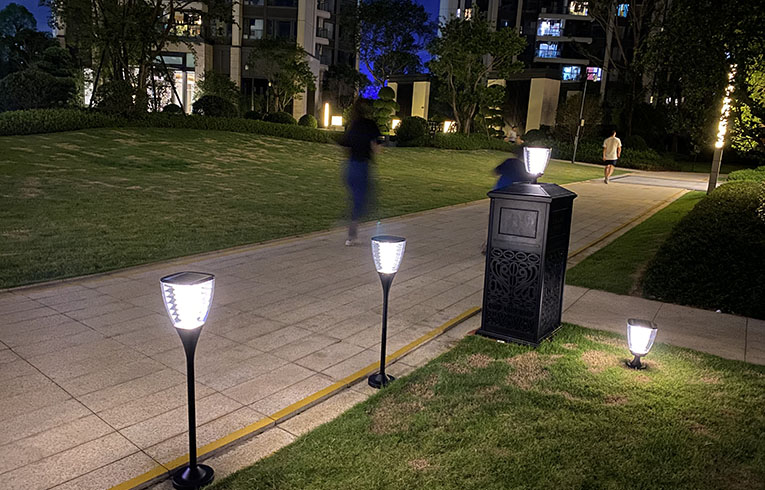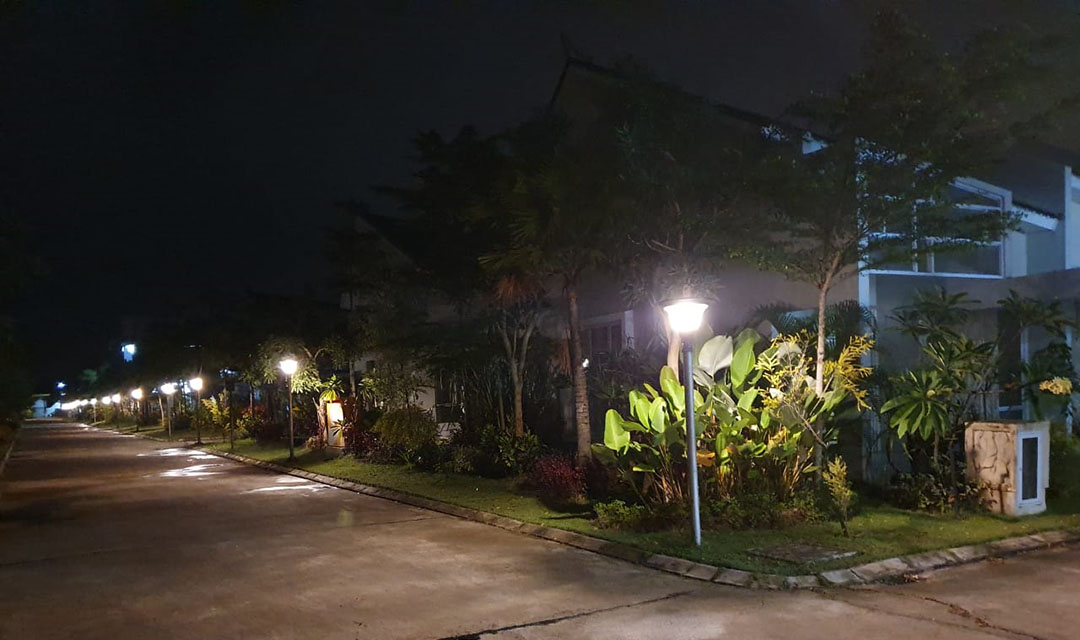Are you considering investing in solar lights with batteries, but are uncertain how they work and the benefits you can experience? In this blog post, we will take a deep dive into the components of solar battery lighting systems and explain their various functionalities. Furthermore, we’ll review some of the potential advantages that can come from utilizing these structures to light your commercial property or home. From cost-effective energy savings to convenience and reliability, learn why so many people are turning towards solar light options for their outdoor illumination needs!
Components of Solar Lights
-
Solar Panel: The solar panel absorbs sunlight and converts it into electricity. It is typically made of monocrystalline or polycrystalline silicon cells and is mounted on the light fixture or a separate mounting structure.
-
LED Light: The LED (Light Emitting Diode) lamp is an energy-efficient light source that provides bright and consistent illumination. LED lights have a longer lifespan and consume less power compared to traditional lamps such as incandescent or CFL bulbs.
-
Battery: The battery stores the electricity generated by the solar panel during the day. It powers the LED light when the sun goes down. Common battery types used in solar lights include lithium-ion, lithium iron phosphate (LiFePO4), and nickel-metal hydride (NiMH) batteries.
-
Charge Controller: This component regulates the charging and discharging process of the battery, ensuring its optimal performance and longevity. It prevents overcharging or deep discharging, which can damage the battery.
-
Light Sensor: The light sensor detects the ambient light levels and automatically turns the LED light on at dusk and off at dawn.
-
Motion Sensor (optional): Some solar lights feature motion sensors that increase the brightness when movement is detected, conserving energy when no activity is present.

How Solar Lights Work
During the day, the solar panel absorbs sunlight and converts it into electricity. This electricity is then stored in the battery through the charge controller. When daylight fades, the light sensor detects the change in ambient light levels and sends a signal to turn on the LED light. The stored energy in the battery powers the LED light throughout the night.
In some solar lights, a motion sensor is integrated to conserve energy by dimming the light when no movement is detected. When the sensor detects motion, the light’s brightness increases to provide better visibility and security.
Solar lights are an effective solution for areas with limited access to the electrical grid or those looking to reduce their carbon footprint. They provide reliable illumination without the need for trenching, wiring, or high electricity costs, making them an attractive option for homeowners, businesses, and communities alike.

How to install Solar Lights
Installing solar lights is a simple and cost-effective way to illuminate your outdoor spaces. Here are some key points you need to know before installing solar lights:
1. Choose the Right Type of Solar Light
Select the appropriate type of solar light based on your needs and the area you want to illuminate. Some common types of outdoor solar lights include pathway lights, wall lights, spotlights, floodlights, string lights, and lamp posts. Consider factors such as brightness, coverage area, and design when choosing your solar lights.
2. Optimal Location for Solar Panel
To maximize the efficiency of your solar lights, ensure that the solar panel receives direct sunlight throughout the day. Place the solar panel in an open area with minimal shade or obstructions. If possible, adjust the angle of the solar panel to face the sun directly for optimal exposure.
3. Proper Spacing and Height
When installing solar lights, consider the spacing and height to achieve the desired lighting effect. For pathway lights, space them evenly along the path, typically 6-8 feet apart. Wall lights, spotlights, and floodlights should be mounted at a height that provides optimal illumination without causing glare.
4. Easy Installation Process
One of the advantages of solar lights is their easy installation process. Most solar lights do not require wiring, making the installation quick and hassle-free. Simply follow the manufacturer’s instructions to assemble and secure the lights in the desired location. Some solar lights come with ground stakes for easy placement in soil or grass, while others may require mounting brackets or screws for attaching to walls or other surfaces.
5. Consider Motion Sensors (optional)
Solar lights with motion sensors can provide additional security and energy conservation. These lights only turn on or increase brightness when motion is detected, conserving battery life and providing targeted illumination when needed.
6. Maintenance and Care
To ensure the longevity and performance of your solar lights, perform regular maintenance and care. Clean the solar panel and light fixture periodically to remove dust, dirt, or debris that may affect their efficiency. Replace batteries when they no longer hold a charge, and inspect LED bulbs for any signs of reduced brightness or wear.
By considering these factors and following the manufacturer’s instructions, you can successfully install solar lights in your outdoor spaces. Solar lights offer an eco-friendly, energy-efficient, and low-maintenance lighting solution that enhances the beauty, safety, and functionality of your outdoor areas.

Choosing the Right Batteries & Placement for Your Solar Lights
To achieve maximum efficiency for your solar lights, it is crucial to choose the right batteries and proper placement. Here are some tips to help you optimize the performance of your outdoor solar lights:
1. Select the Right Batteries
The battery type and capacity play a significant role in the performance of your solar lights. Some common battery types used in solar lights include:
- Lithium-ion (Li-ion): These batteries have a high energy density, long lifespan, and low self-discharge rate, making them an excellent choice for solar lights.
- Lithium Iron Phosphate (LiFePO4): LiFePO4 batteries offer greater safety, longer life cycles, and better thermal stability compared to regular lithium-ion batteries.
- Nickel-Metal Hydride (NiMH): NiMH batteries are an eco-friendly option with a good energy density and a longer lifespan than Nickel-Cadmium (NiCd) batteries.
Always follow the manufacturer’s recommendations for battery type and capacity to ensure optimal performance and longevity.
2. Proper Placement of Solar Panel
To maximize the efficiency of your solar lights, place the solar panel in a location where it receives direct sunlight throughout the day. Avoid placing the panel in shaded areas or under overhanging branches, as this can significantly reduce the charging capacity. If possible, adjust the angle of the solar panel to face the sun directly for optimal exposure.
3. Consider the Sun’s Path
When positioning the solar panel, take into account the sun’s path throughout the day and across different seasons. The solar panel should receive maximum sunlight during the peak hours of the day when the sun is at its highest point.
4. Balance Aesthetics and Functionality
While placing your solar lights, consider both aesthetics and functionality. Ensure that the lights provide adequate illumination for the intended area while also enhancing the overall appearance of your outdoor space. Proper spacing and height are crucial factors to achieve the desired lighting effect.
5. Regular Maintenance
To maintain the efficiency of your solar lights, perform regular maintenance and care. Clean the solar panel and light fixture periodically to remove dust, dirt, or debris that may affect their efficiency. Check the batteries regularly and replace them when they no longer hold a charge.

Understanding Photovoltaic Cells
Photovoltaic (PV) cells, also known as solar cells, are the key component in converting sunlight into electricity. They harness the sun’s energy and turn it into a usable form of power. To understand how photovoltaic cells work, it’s essential to know their basic structure and the principles behind the photovoltaic effect.
Structure of Photovoltaic Cells
PV cells are typically made from semiconductor materials, most commonly silicon. A solar cell consists of two layers of silicon: one with a positive charge (p-type) and the other with a negative charge (n-type). These layers are created by introducing impurities (doping) into the silicon, forming a p-n junction.
The top layer of the solar cell is usually thin and transparent, allowing sunlight to pass through and reach the silicon layers beneath. Metal contacts are placed on the top and bottom of the cell to collect and transfer the generated electricity.
The Photovoltaic Effect
The photovoltaic effect is the process through which sunlight is converted into electricity within the PV cell. When sunlight (composed of packets of energy called photons) strikes the surface of the solar cell, it can dislodge electrons from the atoms in the semiconductor material.
If a photon has enough energy, it can knock an electron free from its bond, creating a “hole” where the electron was previously located. The freed electron then moves to the n-type layer, while the hole moves to the p-type layer. This movement of electrons and holes creates an electric field at the p-n junction.
As more sunlight hits the solar cell, more electrons are dislodged, and the electric field at the p-n junction becomes stronger. When an external electrical circuit is connected to the solar cell, the electrons flow through the circuit, generating electricity.
Factors Affecting PV Cell Efficiency
Several factors can impact the efficiency of a photovoltaic cell in converting sunlight into electricity:
- Material: The choice of semiconductor material plays a crucial role in PV cell efficiency. Monocrystalline silicon is currently the most efficient, followed by polycrystalline silicon and thin-film materials.
- Sunlight Intensity: The amount of sunlight directly affects the output of a solar cell. More sunlight results in more electrons being dislodged and a higher electric current.
- Temperature: Higher temperatures can negatively impact the efficiency of a PV cell. As temperature increases, the output voltage decreases, reducing the overall power output.
- Angle of Incidence: The angle at which sunlight strikes the solar cell also influences its efficiency. For maximum efficiency, the solar cell should be positioned to face the sun directly.
Pros and Cons – Balancing the Benefits of Solar Lights with Battery Usage
Solar lights with battery usage offer an eco-friendly and energy-efficient alternative to traditional outdoor lighting systems. However, as with any technology, there are both advantages and disadvantages to consider. Here’s a balanced look at the pros and cons of solar lights with battery usage:
Pros:
-
Environmentally friendly: Solar lights use renewable energy from the sun, reducing greenhouse gas emissions and dependence on fossil fuels.
-
Energy-efficient: Solar lights are powered by energy-efficient LED bulbs, which consume less energy than traditional incandescent or CFL bulbs.
-
Low operating costs: Since solar lights rely on sunlight for power, they have minimal operating costs, leading to long-term savings on electricity bills.
-
Easy installation: Most solar lights do not require wiring, making installation quick and hassle-free. This feature also makes them ideal for remote or hard-to-reach locations without access to the electrical grid.
-
Automatic operation: Solar lights typically include a light sensor that automatically turns the light on at dusk and off at dawn, ensuring efficient energy usage.
-
Low maintenance: Solar lights generally require minimal maintenance, such as cleaning the solar panel and occasionally replacing the batteries or LED bulbs.
Cons:
-
Battery lifespan: The batteries in solar lights eventually lose their ability to hold a charge, requiring replacement every few years. Battery performance can also be affected by extreme temperatures.
-
Limited sunlight: Solar lights depend on sunlight for charging, making them less effective in areas with limited sunlight or during extended periods of cloudy or rainy weather.
-
Lower brightness: Solar lights may not be as bright as traditional electric-powered lights. This limitation may not be suitable for all applications or preferences.
-
Initial cost: The upfront cost of solar lights can be higher than traditional lights due to the inclusion of solar panels, batteries, and other components. However, the long-term savings on electricity bills may offset this initial investment.
-
Placement limitations: Solar lights require direct sunlight for optimal charging, which may limit their placement options in shaded or obstructed areas.
Issues to Consider When Installing Solar Lights with Batteries
1. Brightness and Coverage
Choose solar lights with adequate brightness and coverage to illuminate the areas you want to secure. Solar-powered spotlights, floodlights, or motion-activated lights are suitable options for security lighting. Ensure that the LED bulbs provide enough lumens (a measure of light output) to cover the desired area effectively.
2. Motion Sensors
Solar lights with motion sensors can enhance security by detecting movement in the surrounding area. When motion is detected, the lights either turn on or increase their brightness, providing targeted illumination and potentially deterring intruders. Consider the sensor’s range and sensitivity when selecting solar lights for security purposes.
3. Proper Placement
Place your solar lights strategically to cover potential entry points, such as doors, windows, and gates, as well as dark corners and pathways. Ensure that the solar panel receives direct sunlight throughout the day for optimal charging. Keep in mind that the height and angle of the lights can impact their effectiveness in illuminating specific areas.
4. Reliability and Battery Life
Choose solar lights with high-quality components, including batteries, to ensure consistent performance and reliability. Opt for solar lights with lithium-ion or lithium iron phosphate (LiFePO4) batteries, which typically have a longer lifespan and better performance than other battery types. Regularly inspect and replace batteries when they no longer hold a charge.
5. Weather Resistance
Select solar lights with robust weather-resistant features, as they will be exposed to various outdoor elements such as rain, snow, and temperature fluctuations. Look for solar lights with an IP (Ingress Protection) rating that indicates their resistance to water and dust.
6. Integration with Other Security Measures
Consider integrating your solar lights with other security measures, such as surveillance cameras, alarm systems, or smart home systems, to create a comprehensive security system for your property.
7. Maintenance and Care
Regular maintenance and care are crucial to ensure the longevity and performance of your solar lights. Clean the solar panel and light fixture periodically to remove dust, dirt, or debris that may affect their efficiency. Check the batteries and LED bulbs for any signs of reduced performance or wear.

To conclude, solar lighting systems are becoming increasingly popular as a cost-effective, reliable and convenient outdoor illumination option. Understanding the components of solar battery lighting systems and how they work can help ensure a successful installation. With all these benefits in mind, it’s no wonder so many people are choosing to invest in this clean energy source. So why not give solar lights with batteries a try at your home or business today?
You’ll be doing your part for the environment while also taking full advantage of this valuable energy resource. It’s quite simply a win-win situation! If you’d like to learn more information about our products or services, please feel free to contact our product managers for more professional sourcing solutions. Thanks for tuning in – we hope you enjoyed learning about the details behind solar battery lighting systems!
Table of Contents